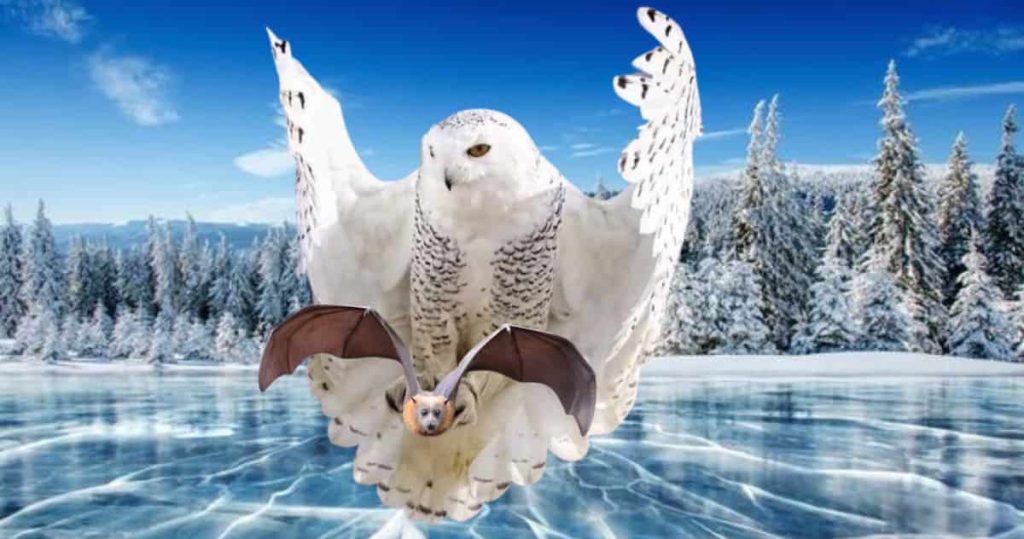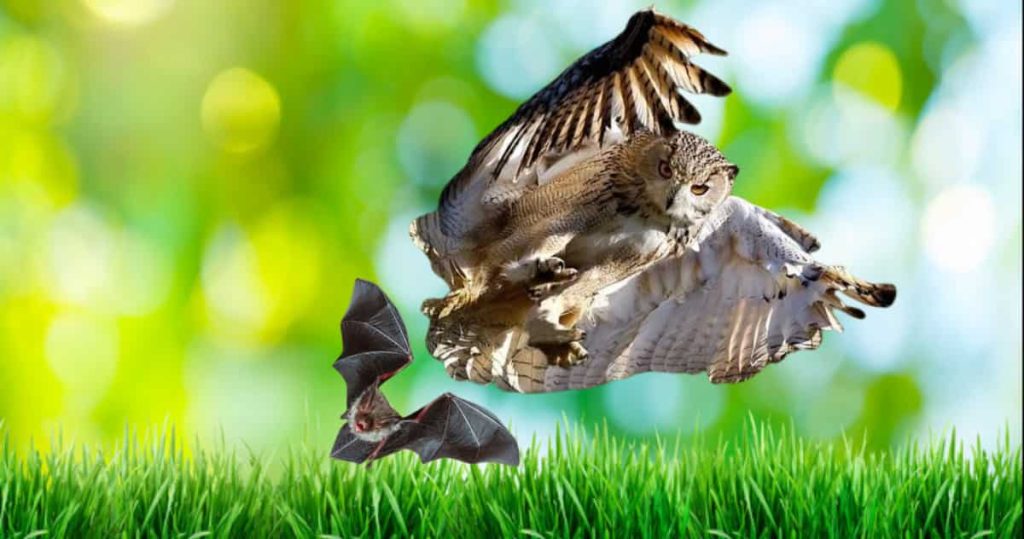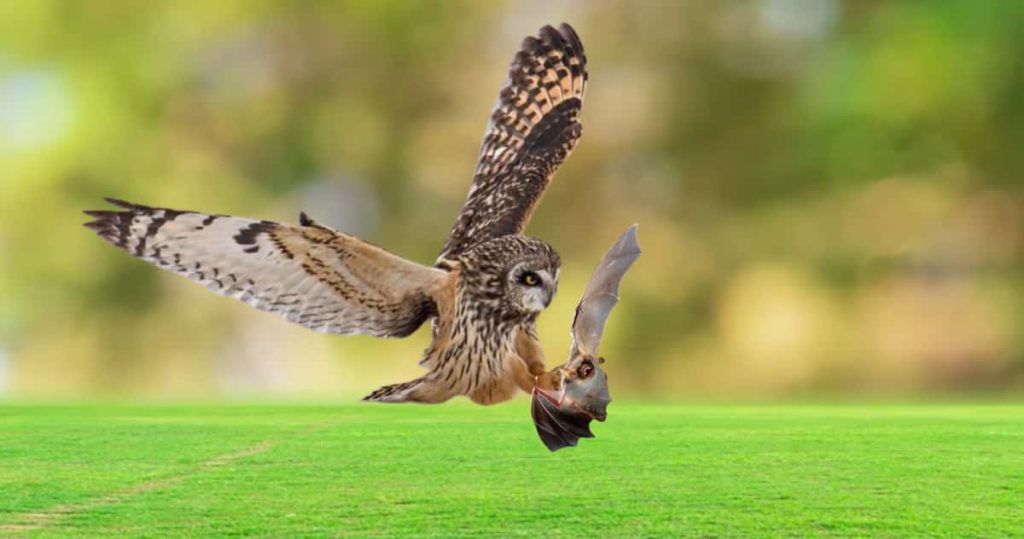
The question that comes into the minds of environmentalists and bat lovers is: Do owls eat bats? Indeed, both bats and owls are nocturnal animals. Bats are mammals and owls are birds, they hunt and eat at night.
Although bats feed on fruits without prey, owls completely depend on prey. So, at night, bats can be prey for ravenous owls.
Again, many birders and environmentalists like me sometimes try to find the answer to the question of whether owls eat bats, does that apply to all bats? Can bats eat owls? Which animals eat bats? Can Owls and Bats Coexist? Let’s follow the correct answers to these questions.
Contents
- 1 Do all owls eat bats?
- 2 Which owls are most likely to eat bats?
- 3 What types of owls do not eat bats?
- 4 What do owls eat other than bats?
- 5 What animals eat bats?
- 6 Which Bats are eaten by owls?
- 7 How Do Owls Catch Bats?
- 8 Can Owls and Bats Coexist?
- 9 Where do Owls Hunt for Bats?
- 10 How can I protect bats from owls?
- 11 Are Bats Afraid of Owls?
- 12 Will a fake owl keep bats away?
- 13 Do bats eat owls?
- 14 How are owls and bats different and similar?
- 15 Nocturnal Animals:
- 16 Predatory Nature:
- 17 Active Senses:
- 18 Silent Flight:
- 19 Camouflage:
- 20 Species:
- 21 FAQs
- 22 Conclusion
Do all owls eat bats?

Owl expert Himo Mikola has been studying owls and their biology for 60 years. He has visited 137 countries and brought out various information about owls.
According to him, bats are not prey to all types of owls. Bats are listed in the diet of several owls, such as Barn Owl and Tawny Owl accounting for the highest of the total bat consumption at around 40-50%.
However, most owls do not have bats as a major food in their diet. They occasionally prey on bats when other food is scarce.
The owls listed in this type are Long-Eared owls, Short-Eared owls, and Eagle owls. Several owls do not catch bats for their diet.
Which owls are most likely to eat bats?
Below are the names of several owls known to eat bats. However, these may vary based on the owl’s habitat, availability of food, list of food sources, etc.
- Barn Owl (Tyto alba)
- Great Horned Owl (Bubo virginianus)
- Eastern Screech Owl (Megascops asio)
- Western Screech Owl (Megascops Kennicottii)
- Northern Saw-whet Owl (Aegolius Acadicus)
- Barred Owl (Strix varia)
- Spectacled Owl (Pulsatrix Perspicillata)
- Long-eared Owl (Asio otus)
- Eagle owls (Bubo bubo)
- Short-eared Owl (Asio Flammeus)
- Tawny Owl (Strix aluco)
- Ural Owl (Strix uralensis)
- Spotted Owl (Strix occidentalis)
What types of owls do not eat bats?

Owls of this species usually hunt other prey such as small mammals, birds, insects, and amphibians instead of bats. But sometimes their choice of food can be changed if there is a shortage of food. Here is a list of owl species that are not typically known to eat bats:
- Snowy Owl (Bubo Scandiacus)
- Burrowing Owl (Athene Cunicularia)
- Elf Owl (Micrathene Whitneyi)
- Northern Pygmy Owl (Glaucidium Gnoma)
- Eurasian Pygmy Owl (Glaucidium Passerinum)
- Flammulated Owl (Psiloscops Flammeolus)
- Boreal Owl (Aegolius Funereus)
- Southern Boobook (Ninox Novaeseelandiae)
- Eastern Grass Owl (Tyto Longimembris)
- African Grass Owl (Tyto Capensis)
What do owls eat other than bats?

Each owl has a specific area to live in and they are very aware of their area. However, after a few years or at certain times of the year, many species of owls change their territory.
How long do owls stay in one place depends on the food available in that area and the environment, so often owls change their diet as their habitat changes.
An owl’s diet can vary based on habitat and food needs. However, below is a list of foods commonly eaten by owls: –
Mammals:
Owls usually hunt for eating small mammals like rats, mice, shrews, voles, rabbits, hares, moles, etc.
bird:
Small birds such as sparrows, finches, and warblers, along with pigeons, doves, and waterfowl, are hunted by owls.
Insects:
Beetles, moths, crickets, grasshoppers, spiders, and other arachnids are also owl’s diet.
Amphibians and Reptiles:
Owls often prey on amphibians and reptiles such as frogs, toads, tadpoles, lizards, and small snakes.
Fish:
Several owls are famous for hunting fish, such as Blakiston’s Fish Owl, and the African Fishing Owl. They usually live near water bodies and hunt fish at night.
Other Small Animals:
Some large species of owls hunt larger mammals like raccoons or skunks.
What animals eat bats?

Besides owls, several birds of prey like hawks, eagles, and falcons hunt bats and several species of snakes do that.
Several types of mammals that are carnivorous such as foxes, raccoons, and weasels eat bats, several species of monkeys are found in this list.
Some bat species are cannibals within their species. Larger insects such as mantises and spiders have been traced to eating bats, although not many.
Some large species of spiders eat bats by trapping them in their webs.
Also, when bats go to a river or other water bodies to cool off, some species of crocodiles and alligators prey on them.
Which Bats are eaten by owls?

But owls do not or cannot hunt all species of bats. Owls usually prey on smaller and lighter species of bats. They prefer some sorts of bats, which are discussed below:
- Smaller Insectivorous Bats (Hipposideros armiger)
- Larger Fruit Bats (Megachiroptera)
- Common Noctule (Nyctalus Noctula)
- Evening Bats (Nycticeius humeralis)
- Kuhl’s Pipistrelle (Pipistrellus kuhlii)
- Mouse-eared bat (Myotis Myoti)
- Long-Eared Bats (Plecotus auritus)
- Parti-Coloured bat / Rearmouse (Vespertilio Murinus)
- Rhinolophidae Bats (Rhinolophidae)
- Common Pipistrelle (Pipistrellus Pipistrellus)
- Serotine Bat (Eptesicus Serotinus)
How Do Owls Catch Bats?
Bats perceive the presence of prey and predators by reflecting sound waves through their mouths. However, they can’t view anything with their eyes. Owls are efficient at hunting other flying prey such as birds and bats.
Most owls can mingle their body with the environment. They lie waiting for the right prey. When the prey comes within reach of the owl, the owl can pounce on the bat with the right timing.
At first, they hold the bat tightly with their curved toenails, sometimes under the pressure of their sharp toenails many bats die in a short time. They then tear Shika to shreds with their hard beaks and eat them.
Can Owls and Bats Coexist?
Although both owls and bats are nocturnal, their diets differ. Owls are carnivores and usually feed on small mammals, birds, insects, and other animals.
Bats on the other hand mostly eat insects, fruits, and sometimes small vertebrates. Although several species of owls hunt several species of bats, other species of owls and bats have often been found to be omnivorous.
Bat roosting patterns and owl roosting patterns are completely different, so it’s not too difficult to distinguish between them.
Common Pipistrelle Bat (Pipistrellus pipistrellus) and Tawny Owl (Strix aluco), Big Brown Bat (Eptesicus fuscus), and Great Horned Owl (Bubo virginianus), Mexican Free-Tailed Bat (Tadarida brasiliensis) and Barn Owl (Tyto alba), and Little Brown Bat (Myotis lucifugus) and Long-eared Owl (Asio otus) are seen everywhere together.
Where do Owls Hunt for Bats?
Owls usually hunt bats in their habitats, which are caves, fields, and forests, where bats take shelter during the day, owls come at night to hunt bats.
Now, when bats gather in groups to collect their food, owls take the opportunity to attack bats.
Sometimes bats come to the pond to cool off and drink water or sometimes owls attack them when they come to hunt small insects in the pond.
In urban areas, bats come to feed on insects attracted by street lights, and owls attack the bats there.
How can I protect bats from owls?
Both bats and owls have an important role in ecosystems. So, we must protect both bat and owl species.
You can take the help of local wildlife experts to help conserve bats in your area. To protect bats that owls have access to, you can build bat houses, remove objects that owls are attracted to, and remove bat areas.
Many artificial lights that attract owls, must be removed, and it has been found that owls hunt bats when their food is scarce. So, we must also pay attention to that.
Are Bats Afraid of Owls?
Owls and bats are nocturnal animals living in the same area. Several owls feed on bats. So, many small species of bats fear owls. Because owls will catch bats for their diet when their food is scarce
Fear is an instinctive response that has evolved as a survival strategy in every living organism. Both owls and bats roost at night to gather their food.
Therefore, most of the time they become each other’s soaps. When the bat learns the position of the owl, it leaves the place.
Will a fake owl keep bats away?
Although bats have an important role in ecosystems, bats often live in homes with humans. This is a big problem for many of us because bats carry many major diseases.
In addition to that, Bat defecates at the place where it lives. Many owls hunt bats, so many of you may be eager to know whether keeping a fake owl at home helps to repel bats or not. The answer is no.
The reason is that bats cannot see, they recognize prey and predators by sound and smell. So, if you want to remove bats from your home, remove things that attract bats, and get help from wildlife experts if needed.
Do bats eat owls?
Both bats and owls are predators. Some species of owls eat bats, but bats cannot eat owls.
Bats primarily feed on insectivores such as moths and beetles along with a variety of fruits in their diet, whereas small vertebrates such as rodents, snakes, frogs, birds, rabbits, etc. make owl’s diet.
There are several large species of bats that attack smaller species of owls or owlets when given the opportunity.
However, the phenomenon is quite uncommon. Many times, bats have been seen eating dead owls.
How are owls and bats different and similar?
There are some similarities in their characteristic, species, and hunting strategy, and the differences between bats and owls are discussed below.
Nocturnal Animals:
Both bats and owls are nocturnal animals who are mostly active at night. This adaptation reduces their efforts to wait during the day to forage at night.
Predatory Nature:
Although both bats and owls are predators, bats primarily eat insects, although some species eat fruit, fish, and some small vertebrates such as frogs. And owls are considered carnivores, they hunt and eat small mammals, birds, and insects.
Active Senses:
Both bats and owls have several active senses. For example, bats emit high-frequency sounds that are transmitted to a prey or object and bounced back to the bat, allowing the bat to perceive the prey’s size, location, and location.
On the other hand, owls have keen night vision and hearing that help them detect their prey’s subtle movements and sounds.
Silent Flight:
Both owls and bats can fly silently, allowing them to approach their prey in a targeted manner.
Camouflage:
Owls and bats choose places to live and hunt where they can easily blend their body color with the environment.
Species:
Bats are mammalian predators and owls are avian predators. There are about 1,400 species of bats and about 254 species of owls in the world.
FAQs
Q. Can owls eat bats?
Ans: Some owl species like Barn Owl, Barred Owl, Eastern Screech Owl, Great Horned Owl, Northern Saw-whet Owl, Western Screech Owl, etc. have bats in their diet.
Q. Do barn owls eat bats?
Ans: Barn owls are a species found almost everywhere in the world. They sometimes eat bats.
Q. Do barred owls eat bats?
Ans: Barred owls are medium-sized owls that hunt and eat bats.
Q. do tawny owls eat bats?
Ans: This medium-sized owl sometimes eats bats.
Q. do screech owls eat bats?
Ans: Eastern Screech Owl and Western Screech Owl are two species of owls that eat bats like other owls.
Conclusion
I hope you have developed a good idea about the answers to the “Do owls eat bats question in this article”.
It’s important to know that these two species have an effective role in maintaining the ecological balance of the environment, so we must ensure their existence to secure the balance.
Although bats are largely absent from the diet of owls, several large species of owls do eat bats. Owls hunt bats when other food sources fall short in the environment. To preserve these two species, we should take advice from environmental experts.